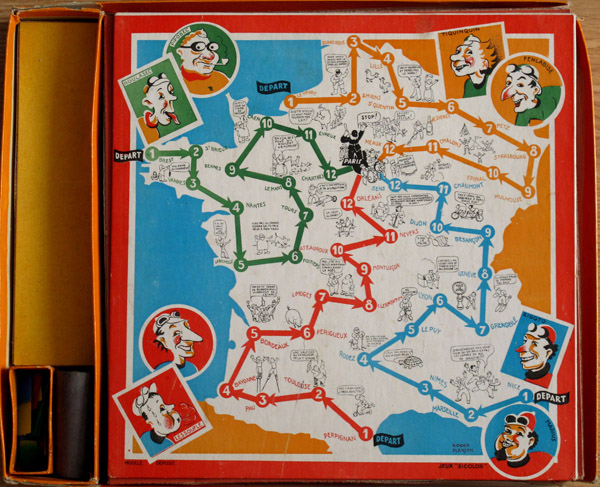
GRANDE COURSE ZIG-ZAG À
RETARDEMENTS
Sicolor, France,
1950s

Humoristic game from François Cardinet's collection. Though it looks like a kids game, it is not exactly so, since players bet (though, supposedly, with chips, not with real money) and the board is full of mentions to alcoholic beverages.
Players used coloured dice, with which they either advance one or two towns, get blocked, or pay a chip to the pot. The first player to reach Paris gets the contents of the pot.

There are several versions of the game. Here is a smaller version from Pierre & Bilou's collection. What's strange is that on this (also smaller) board one of the riders (round red rider on the bottom left) does not have name.

Here's the front of the smaller box.
It looks like the former owner did not like (or maybe liked too much) the label on it.
By the way, all 8 riders have names on this label.

There are four different starting points on the board, which is quite sensible since the riders are quite big. This makes the race more similar to the Montecarlo rally than to the Tour de France.

The refreshments are mainly alcoholic. This, of course, would be unthinkable nowadays.



UPDATE may 2020:

Here is a third box, with a different (and nicer) in-box organization. You cannot see it on the picture but the board has all eight names. What is strange in this one is that the rules are different from the previously known versions pictured above. Didier Maria (thanks again!) has been kind enough to send me these rules.

On one hand, there are rules for solo play. On the other hand, the rules for multiple players are different form the ones in the other boxes. In these rules (both for solo play or for multiple players), cyclists move if the special "sicolor" die throw matches their colour. Since there are only 4 cyclists, the other two colours are bad throws carrying some kind of penalty.

However, in the other rules (see above), the colour of the die throw has no relation whatsoever with the colour of the cyclists. I do not know which were the original rules and which the variation. What I can tell is that these newly found rules are obviously more elegant (with the other rules, one wonders what is the use of having a colour die in the first place). My guess is that these are the original rules, but further research is needed to be sure.
UPDATE december 2022: Caspar Mol from Utrecht has sent this picture of another game by the same maker. He is looking for more information on Jeux Sicolor. To make a long story short: Caspar started a site on Mobaco, a Dutch construction toy. While researching the origins of Mobaco, he discovered L’Édifice, a similar French game, and he decided to start a website on that one too (still under construction), documenting the toy in all its details before the information is lost. It turns out that the makers of L'Édifice, Méricant, also made a game called Le Sicolor, so now Caspar would like to find out whether there is a relation between Jeux Sicolor and Méricant. He thinks there might be a connection, while my first guess (just an intuition, actually) is that there isn't. Any information will be welcome.

 |
 |
 |
 |
 |
|
CULTURE IDEAS |
TOTUM REVOLUTUM THUMBNAILS |
NAMES ALPHABETICAL |
CATEGORIES LISTS |
WHAT'S NEW BLOG |